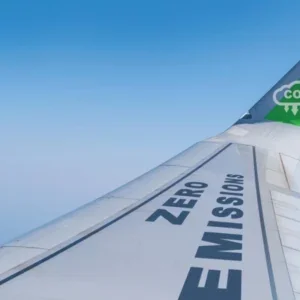Having successfully reached the airport in good time, checked in and passed through security with ease, you’re feeling pretty happy with yourself. You mill around the duty-free shop, eyeing up bargains before settling in a cafe on the concourse. You can take your time. After all, the departure gate is only a hop and a skip away, isn’t it?
Except it’s not; it’s roughly 1km away, which you, engrossed in a gripping novel, fail to account for. It’s something you wish you’d known before the call for boarding flashes on the departure screen above your head, before that frantic run down what feels like a never-ending corridor – before you miss your flight.
It’s a cautionary tale some of us may well relate to. In line with the birth of the ‘Aerotropolis’ concept, many international airports are becoming increasingly comparable to towns and cities, as opposed to mere transport hubs.
A helping hand
When one sets foot in the likes of Schiphol and Heathrow, one navigates a sprawling miasma of shops, restaurants, bars and escalators. It is easy to be swept up in such features, and underestimate, say, the walking time to a departure gate.
This is precisely what makes iBeacon technology so appealing. The beacons can broadcast in different parts of an airport and are small, wireless devices that transmit a short-range Bluetooth signal, meaning passengers need only look at an app on their phone to avail themselves of a host of information, from real-time walking directions to estimated travel times.
Last year, Miami International Airport became one of the world’s first hubs to officially introduce such technology, installing more than 500 beacons across its vast 7.5-millionsquare- foot surface area.
The beacons can be found at the facility’s main entrances, airline gates, check-in desks, baggage claim area and parking zones. The app – ‘MIA Airport Official 2.0’ – is effectively a personal travel assistant, allowing users to scan boarding passes, and even receive shopping and dining suggestions tailored to their personal profiles.
According to Maurice Jenkins, Miami International’s division director for information systems, the introduction of beacons was no overnight decision, but, rather, the result of long and careful consideration.
“We are constantly evaluating new technology for our operations, and determining whether it is an emerging market trend worth adopting,” he explains. “With a low implementation cost and high potential return on investment, we were able to generate a positive consensus from our stakeholders on beacons.”
Before deciding on the technology, Miami International also trialled near-field communication (NFC), buying up hardware to support airlines that had expressed an interest in going with NFC. Not long after, however, Jenkins noticed iBeacon – introduced by Apple in 2013 – was starting to crop up in debate at various aviation forums. The seeds of an idea were sown.
“We saw it as a new market item that was gaining momentum and industry support,” he says. “Since iBeacon is an open, non-proprietary system, that also meant open market competition and pricing for future initiatives. Before that, NFC was being billed as the latest and greatest technology that airports were going to use and leverage. It gained a lot of traction, but it also lost a lot, too. It happens often with new technologies.”
Miami International began trialling beacons in 2014, using an open standard common-use beacon registry provided by air transport information technology specialist SITA. The trial’s outlay was comparatively inexpensive.
“If you compare it to some of the other major IT initiatives that airports have embarked on in years gone by, it was cheap,” says Jenkins. “We are not talking about hundreds of thousands of dollars here – just a few thousand.”
Since the trial began, the app has enjoyed around 185,000 downloads. Have passengers voluntarily sought it out, or have they needed a slight push in the right direction?
“They are downloading it voluntarily,” he says. “Yes, we’ve done some product launches, but its success has been quite organic. We continue to see a healthy number of weekly downloads through organic outreach, while monthly downloads have remained strong since the integration of beacons. We’ve not had to really add any kind of enticement. We have received great responses on social media platforms over its usability, too.”
When Miami International first rolled out the beacons, the focus was primarily on customers. However, it has also made staff-members’ jobs easier, says Jenkins.
Armed with information such as shopping and dining suggestions at the touch of a screen, employees can provide better interaction-led assistance to passengers. In using the app themselves, it also serves as a promotional opportunity to get passengers to download it if they haven’t done so already.
“The next iteration of the app we are looking at will focus on employees,” says Jenkins. “So we are starting to look at things like promotions for restaurants and wait times for employee shuttle buses to get to the parking lot, as well as anything else that they might have a beneficial need for. We’ve had some discussions, and have started to evaluate some processes of how we can actually put all of that into one app.”
Total beacon hardware and installation costs at Miami International to date stands at $850,000. And it has been “well worth the investment”. Jenkins doesn’t reveal exactly how return on investment is being measured, but a great deal of weight is given to customer feedback. “If they are using the app, and we are getting positive comments back, we can leverage that and put it to good use,” he explains.
Jenkins has a mantra: “to maximise technology to support more than just one initiative where we can”. How does this tie into beacon technology?
“Right now, we’ve got the wayfinder and turn-by-turn navigation – and it’s working really well – but we are also looking to introduce additional functionality within the app itself,” he explains. “So, as part of our next steps, we are going to introduce proximity campaigning, which will allow us to issue push notifications and offer promotions. Basically, catering to the customer a little bit more, and also allowing them to decide what they do, and do not, want to receive. This then adds value.”
Beacons beyond
Beyond Miami International, the adoption rate of beacons has been surprisingly slow. Copenhagen Airport has trialled the technology, but remains reluctant to push ahead with full-scale installation.
Hong Kong International Airport has also trialled beacons, but is yet to roll out anything official.
What’s at the root of this scepticism? Part of this is down to it simply being a case of early days. Just as the retail industry continues to get to grips with harnessing beacons to its advantage, so must the airport sector exercise the same patience.
Then there’s also the welter of Bluetooth technology currently on the market, which Apple does not hold complete sway over. Google, too, has its own platform – Eddystone – although its open-source nature has raised eyebrows over security risks.
“A lot of this is to do with how you can continue to leverage technology within the global marketplace, or if you want to look at it from the vantage point of the entire industry as a whole,” says Jenkins, who sits on several boards focused on introducing new technologies into the air transport industry. “So when it comes to beacons in airports, we need to be looking at other innovative things. For instance, we are looking at how putting sensors in garbage cans can let us know when they are full and help us be more proactive.
“We are also talking about securing and providing you with pure, accurate data. There are a lot of things coming down the pipeline that we are trying to put together in order to have seamless passenger flows, which benefit the industry as a whole.”
According to SITA, 83% of passengers now carry smartphones, while over a third of airlines are believed to have invested in an internet-of-things initiative.
For this reason, the need for smart airports will only grow. Beacons have the potential to not only engender greater harmony for passengers, but to generate predictive models that allow airports to allocate resources where they are needed most.
Air travel is increasing year on year, too. According to the International Air Transport Association, demand was up by 6.3% last year compared with 2015, with capacity rising by 6.2%.
With more of us taking to the skies, the introduction of new tech, such as beacons, could make all the difference between the airports able to successfully handle larger numbers of passengers, and those that can’t.






